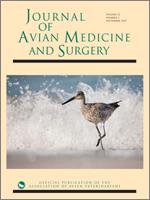A wild-caught lesser flamingo (Phoeniconaias minor) from the Fort Worth Zoo (Fort Worth, TX, USA) presented with moderate lameness that progressed to the inability to stand 2 days after restraint and handling. Results of blood tests showed severely elevated creatine phosphokinase (CPK) and aspartate aminotransferase (AST) activities, confirming suspected capture myopathy. Intensive supportive therapy, consisting of intravenous fluids and muscle relaxants, along with physical rehabilitation therapy, nutritional support, and anxiolytics, were instituted to aid in relaxation and muscle regeneration. After 2 weeks of intensive therapy, the bird showed substantial improvement and could remain standing throughout the day after being assisted to a standing position. By day 23, the bird was able to stand independently and walk completely unassisted, with no discernible lameness. The bird has subsequently remained healthy since it was returned to the flock approximately 27 days after it was first presented for treatment. Although anecdotal communications of successful treatment of this condition in flamingos exist, this is the first report, to our knowledge, that describes in detail the successful treatment of capture myopathy in any flamingo species. Success in this case is attributed to the combination of early fluid and drug therapy, intensive physical rehabilitation therapy, and anxiolytics to counteract the hyperexcitable nature of this wild-caught bird.
How to translate text using browser tools
1 September 2017
Multimodal Drug Therapy and Physical Rehabilitation in the Successful Treatment of Capture Myopathy in a Lesser Flamingo (Phoeniconaias minor)
Michael Stephen McEntire,
Carlos R. Sanchez
ACCESS THE FULL ARTICLE
anxiolytics
Avian
Capture myopathy
hyperexcitability
lesser flamingo
Phoeniconaias minor
physical rehabilitation therapy





